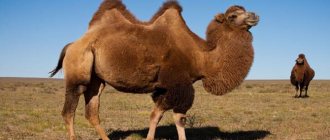Camels: brief description
These animals belong to the class of mammals, and belong to the genus of artiodactyl herbivores. According to the international classification, humpbacked desert dwellers are representatives of the suborder Callopods, which also includes two more species of camels' closest relatives - the South American llamas and vicuñas.
The height of adult camels ranges from 190 to 210 cm, and their weight reaches 400-800 kg. In these animals, differences in gender are clearly visible, and females are always smaller and more graceful than males.
Camels are diurnal, and for the most part lie down, saving energy reserves, and if necessary, they move only to water or in search of food. In particularly cold weather, humpbacks become lethargic and inactive, and may not leave their camp for several days.
Elena
Ask a Question
Question to the expert
Please tell me why some camels have a saggy hump?
A standing hump means that the camel is full and has accumulated nutrients for future use. If an animal has to starve for several weeks, it begins to use up its own reserves from the hump, and the skin growth sags. When the camel sings, its hump will become elastic again and assume a vertical position.
How long can a camel go without water?
All animals living in the harsh conditions of desert regions are adapted to a constant lack of moisture. However, in comparison with them, the camel is the real king of the desert. It can go without water for 10 days while using energy sparingly. With intense activity (running, carrying luggage), this period is halved.
This unique ability of camels is due to the behavior and structure of the body:
- animals lead an inactive lifestyle;
- moisture loss during life is minimized (steam settles as condensate inside the nostrils and flows into the esophagus; sweat glands begin to work only after body temperature rises to +40 degrees; in the alimentary tract, all the liquid contained in the vegetation is extracted from the green mass);
- The camel's body is able to accumulate nutrients and moisture and gradually consume them in the absence of food and drink.
MEERKAT
Physiological characteristics of camels
How do these animals manage to survive in such strict and ascetic conditions? The secret lies in their special physiology, which over the years of evolution has allowed them to perfectly adapt to life in the sultry desert.
- The erythrocyte cells of camels have an oval shape, and when the body is dehydrated, their blood does not thicken, like that of all living creatures, but remains fluid, thanks to which they can do without water for 14 days.
- At one time, a camel drinks up to 200 liters of water. But the main thing is that these animals can drink salt water without harm.
- The thick fur of humpbacked creatures reflects the sun's rays, protecting them from even the most intense heat.
- During sandstorms, the camel's nostrils are closed with special membranes, so the animals can breathe freely.
- There is also a membrane over the eyes (the so-called third eyelid), which prevents sand and dust from entering the mucous membrane.
- Camels have elastic and hard lips, and the upper lip is forked, allowing animals to easily eat even the hardest thorns.
- They have excellent eyesight and can see each other at a distance of 3 km.
- Camels also have an excellent sense of smell, thanks to which they find a source of water, which is located 60 km away.
Bactrian camel - description for children
These artiodactyls have features that help them survive in very extreme conditions. For example, Bactrian camels can experience severe dehydration, characterized by a loss of 40% of fluid. Animal kidneys are capable of absorbing water from urine and delivering it back. Animal red blood cells are oval, so even when the blood is very thick, it remains fluid. These blood cells can also store water. Camel manure is concentrated and consists almost entirely of dry plant fibers.
It is also interesting that the animal’s nostrils are closed; it opens them only when it breathes. Thanks to this, less water evaporates. Another interesting feature is that a camel can only sweat if the temperature rises to 41 degrees. If it continues to rise, it becomes dangerous for the animal's life. At night, the camel's body has a temperature of +34.
Species of desert humpbacks
There may have been more varieties of camels in prehistoric times, but only two species have survived to this day:
- Bactrian camel or Bactrian.
- Dromedary camel or dromedary.
Bactrian camel
Fluffy, with a luxurious mane, a two-humped Bactrian.
Representatives of the Bactrian genus are large and heavy animals. They have long hair that forms a luxurious collar around their neck. With the onset of autumn, Bactrian camels become covered with thick fur, helping the animal survive the winter cold. And at the end of March, they shed their “winter coat” and welcome summer with a lighter and shorter hairstyle. By the way, during the molting period, the Bactrian's fur falls out unevenly, and an animal with shabby areas on its body looks sloppy and unkempt.
dromedary camel
Majestic and imperturbable dromedary
In the distant past, huge herds of dromedary slowly wandered across the endless deserts of the Middle East and North Africa. Now they have become exclusively domestic animals, and dromedary camels are not found in their once familiar habitats. They differ from Bactrians in their smaller size, lighter and shorter coat, and of course, the presence of only one hump.
You will be surprised, but wild dromedaries still exist. True, not in Asia and Africa, but on... the Australian continent. In the 19th century, camels were brought there to solve the problem of transportation to inaccessible desert areas. And with the advent of motor transport, the need for humpbacked movers disappeared, and they were released into the wild. And it should be noted that dromedaries live very freely in Australia, and their population has increased to 750 thousand individuals over the century.
Final table of camel species according to user ratings
Bactrian camel
2
dromedary camel
1
Range, habitats
Camels of both species are quite widespread only in desert zones, as well as in dry steppes. Such large animals are absolutely not adapted to too humid climatic conditions or living in mountainous areas. Domesticated camel species are currently common in many areas of Asia and Africa.
Dromedaries are often found in northern Africa, up to one degree south latitude, as well as in the Arabian Peninsula and central Asia. In the nineteenth century, such animals were brought to Australia, where they were quickly able to adapt to unusual climatic conditions. Today, the total number of such animals in Australia is fifty thousand individuals.
Bactrians are quite widespread in regions stretching from Asia Minor to Manchuria. There are currently about nineteen million camels in the world, and approximately fourteen million live in Africa.
Today there are about seven million camels in Somalia, and just over three million camels in Sudan . Wild dromedaries are believed to have gone extinct at the beginning of our era. Their most likely ancestral home was represented by the southern part of the Arabian Peninsula, but at present it has not been possible to fully establish whether its ancestors were wild-shaped dromedaries or were a common ancestor with the Bactrian. N.M.
During an Asian expedition, Przhevalsky was the first to discover the existence of two-humped wild camels, the Khaptagai. Their existence was assumed at that time, but was not confirmed, and was therefore disputed.
Populations of wild Bactrians today exist only in the Xinjiang Uygur Autonomous Region and Mongolia. The presence of only three separate populations was noted there, and the total number of animals in them is currently about one thousand individuals. Currently, issues related to the acclimatization of wild Bactrian camels in the conditions of the Yakut Pleistocene park zone are being actively considered.
Lifestyle of wild Khaptagai camels
Unlike dromedaries, which have disappeared from their original habitats, Bactrian Bactrians still live in the wild. The Mongols call such camels “haptagai”, which translates from their language as “wild”. Wild Bactrians inhabit isolated areas of two countries - Mongolia and China. The population of these animals is small, and scientists are worried that they, like dromedaries, will soon cease to exist in natural conditions.
Wild Bactrian family
The way of life of the Khaptagai is almost the same as that of their domesticated fellow tribesmen. Wild Bactrians live in small groups of 10-15 individuals and constantly roam in search of food and natural sources of water. Khaptagai are rather shy creatures and try to stay away from people. They will never return to a familiar body of water if they notice a person nearby.
Haptagai, although cowardly, during the mating season, male wild Bactrians show amazing courage and fearlessness. In an excited state, they often attack herds of domestic camels, kill all the males, and take the females with them as war trophies.
Origin of the species and description
Photo: Bactrian camel
Bactrian or Bactrian camel (Camelus bactrianus) belongs to the camelid genus. Class: mammals. Order: artiodactyls. The main differences between the Bactrian camel and other representatives of this genus are not only the presence of a second hump, but also the thick coat of hair. Bactrian camels are very hardy animals; they can easily survive summer drought, snow and frost in winter.
Video: Bactrian camel
Camels are very ancient animals; the first images of a camel date back to the 19th century BC. The first finds of biological remains of ancient camels date back to 2500 BC. Camels were domesticated in the 6th-7th millennium BC. Camels are one of the first animals that people began to breed and raise for their needs. People used and still use camels primarily as transport. Camel wool, from which clothing can be made, and milk, camel meat, which is excellent for food, are also considered valuable. The main populations of camels used to live in ancient Asia.
The first description of this species was made in 1878 by researcher N. M. Przhevalsky. Unlike one-humped camels, two-humped camels have been preserved in the wild. Today, Bactrian camels are divided into 2 species: Camelus ferus is a wild camel and Camelus bactrianus is a domestic Bactrian. Recently, the population of this species has been rapidly decreasing, and humans are to blame for this.
What do camels eat
The digestive system of these animals is formed in such a way that their stomach is capable of digesting even the coarsest and dryest food. It is likely that over thousands of years of evolution, nature itself made sure that camels could survive in the desert, which was poor in moisture and vegetation.
What do camels eat in the desert
Recommended by topic
Fox Panda Lynx
In desert regions there is little choice, so the humpbacked creatures are not particularly capricious and eat any plants they find. Their natural diet includes fresh grasses, shrubs, leaves and young shoots of trees. Camels eat saxaul, wormwood and steppe onions, and also never refuse to eat green cacti. During dry periods, they feed on sun-burnt grass, and can even eat the skins of dead animals.
Dromedary nibbles branches of a bush
What do they feed domestic camels?
Animals kept at home are fed cereals, vegetables and fruits. Camels happily eat wheat, barley, corn, cabbage leaves and freshly cut grass. They are also given grain mixtures and silage, and hay is stored for the winter.
Camels really like fresh, juicy greens.
Nutrition
In terms of food, camels are completely unpretentious, because in the desert it is extremely rare to find the kind of food that wild animals primarily feed on. Camels are accustomed to eating plants of different shapes and colors, and can also go for several days without food at all.
Camels can eat the following types of plants:
- saxaul – branches;
- fresh and dry, burnt grass;
- barnyard;
- poplar leaves;
- sagebrush;
- camel-thorn;
- bushes.
Camels are able to digest even completely inedible food - for example, thorns. In addition, their digestive system processes incoming substances and releases nutritious fiber.
Animals begin to consume poplar leaves and reeds when cold weather sets in. In rare cases, when it gets too cold, Bactrians can eat not only plant food, but also the skins of dead animals.
Camels are also unpretentious in relation to water. For more than a week, the animal does not need to replenish its fluid reserves, provided that it eats fresh grass. But when a spring comes across the way, the camel absorbs a huge amount of liquid - up to 130 liters of water. Domestic camels look for fresh water, but wild khaptagai can even get by with the liquid they get from brackish water bodies.
The animal's diet may vary depending on where it lives. Animals domesticated by people, in addition to plant foods, began to eat some types of vegetables and fruits, as well as silage and grain.
The digestive system of camels is well developed and processes even the coarsest food. All food is swallowed whole, half digested, and then spat out, after which the camel begins chewing. The camel spits not so much saliva as particles of digested chewing gum.
It is believed that dromedaries are more picky eaters - they can only eat plant foods, while Bactrian camels eat animal skins and bones in cold periods.
Hunger is not a problem for these animals. During such periods, the survival rate of animals even increases. For an adult animal, the normal period for fasting is about 30 days. All this time, his body receives nutrients from reserves deposited in the humps.
Mating games and reproduction of camels
Camels are ready to mate and give birth to offspring starting at 3 years of age. Males develop more slowly and reach reproductive maturity only in the 5th year of life. The mating season of camels occurs in autumn-winter, during the seasonal rains, when arid deserts are filled with sufficient water.
Behavior of camels during the rutting season
As soon as the males feel ready to mate, they begin to rush about randomly, emit a loud roar, and flakes of foam fly out of their mouths. Some males become so frantic that in the heat of the moment they even try to have sexual intercourse with young males.
Fight between two males
During the rutting season, male camels turn from calm and cold-blooded creatures into wild and aggressive animals. They organize fierce battles among themselves for the right to mate with a female, and often such fights end in injury or even death of one of the rivals. When fighting, camels use all the methods available to them: kicking with their hind limbs, grabbing the head and neck with their teeth, spitting cobs of saliva at each other. But most often, the dominant male crushes his opponent with his neck, trying to knock him to the ground, and if this succeeds, then the loser is also trampled underfoot.
Mating games pose a danger not only to the camels themselves, but also to people. Shepherds try not to get close to camels unnecessarily, and intervene only in cases where one of the pets is in danger of death.
Males, who have defended their right to procreation, herd the females into one group and do not allow them to scatter. They mark their territory with urine and an odorous substance secreted by the occipital gland. The female, ready for mating, waters her hind legs with copious streams of urine, then bends all her limbs and obediently lies down in front of the male. Interesting fact: camels are the only representatives of herbivores in which the mating process occurs in a sitting position.
Population and species status
Photo: Bactrian camels
Wild Bactrian camels have been considered very rare animals since the beginning of the 20th century. At the moment, the population of Bactrian camels is on the verge of extinction. There are only a few hundred of these animals left in the entire world. According to some sources, about 300, according to other sources, about 900 individuals. The species Camelus bactrianus is listed in the Red Book and has the status of a critically endangered species. Hunting camels has been prohibited for many years, however, poachers still kill the animals. Every year, up to 30 camels are killed by poachers. Most often, poachers waylay animals during migration.
In addition, enormous damage to the population of this species was caused during nuclear tests carried out by China. China's ecology is in a deplorable state, and after these tests, the land and water bodies will be dangerous for many years to come. Nuclear waste pollutes soil and water. And not only camels, but also many other animals die from poisoning and exposure to radiation. Camels were also greatly harmed by the development of gold mining sites and the construction of factories in Mongolia and China.
Interesting fact: An adult camel is so hardy that it can survive even severe dehydration. For an ordinary animal, losing 20% of the water contained in the body is certain death; a camel survives even after losing up to 40% of the fluid.
Camels are leaving their usual habitats because people have come there. Camels are also poisoned by potassium cyanide, which enters the environment during gold processing.
Pregnancy and childbirth
Female camels are able to bear offspring only once every 2 years. After all, these animals have a fairly long gestation period: 13 months for two-humped animals, and 14 months for one-humped ones. As a rule, females bear only one baby. In rare cases, two embryos are formed in the uterus of a camel, and most often a twin pregnancy ends in a miscarriage.
If the fetus is too large or in the wrong position, it is difficult for the female to give birth on her own, and then people have to help the pet by carefully pulling the calf by the hind limbs.
Raising offspring
A newborn camel is a smaller copy of its parents. The only differences are the color of the babies (they are often born white), and the fact that in place of the future hump they have a barely visible fold of skin.
Bactrian camel cubs weigh from 36 to 50 kg at birth, while their one-humped relatives are born larger, weighing up to 100 kg. Already 2 hours after birth, the little camel stands on its legs, is saturated with mother’s milk and is ready to follow the female.
Newborn camel with mother
The lactation period in animals lasts up to one and a half years, but generally the baby is fed milk for no more than 6 months. Camels are very caring mothers, they look after their cubs until they reach sexual maturity. Mature males begin to lead a separate existence, sometimes forming bachelor groups of 5-7 individuals. And young females remain close to their mothers, becoming full members of the herd.
How do they reproduce?
Puberty in camels occurs at the age of 2-3 years. Animals kept in captivity are allowed to mate only for 4-5 years. Camels mate in winter, during the rainy season.
Pregnancy lasts 13-14 months, depending on the breed, after which the female has one baby camel. He is ready to follow his mother 2-3 hours after birth. The camel feeds her baby with milk for up to 12-18 months. Even after the end of lactation, the female continues to look after him, protecting him from dangers.
Do camels have natural enemies?
In prehistoric times, the ancestors of camels were hunted by lions and saber-toothed tigers. But modern “ships of the desert” have almost no enemies in their natural environment. Until recently, camels were attacked by tigers, but the development of new territories by people forced these predators to leave their habitats.
The wolf is the camel's main enemy
The most dangerous enemy of these animals is the wolf. Gray predators attack in whole flocks both wild and domestic camels, which are extremely defenseless against wild animals. Surprisingly, camels do not even try to fight off wolves, and do not think of using their powerful limbs. According to eyewitnesses, when attacked by predators, these creatures limit themselves to loud screams and spitting, which, naturally, cannot scare away a hungry wolf aiming at large prey.
Interesting Facts
- These representatives of artiodactyls are capable of eating 30-40 kg of food per day.
- Female Bactrian camels produce about 800 liters of milk per year.
- Bactrians is what the ancient Greeks called these animals. They were nicknamed in honor of Baktrin, which was the center of agriculture and was located within the Amu Darya.
- You can shear 10-12 kg of wool from one camel per year.
In extreme situations, animals can eat ropes and tents.
Domesticated camels
There are no records or reliable sources that could tell when exactly people began to domesticate camels. Scientists believe that the domestication of these animals occurred in the period 4-1 millennium BC. At first they were used to transport goods, and it can be said that camels made a significant contribution to the development of trade between nomadic tribes and people from different cities. After all, these amazing creatures became the only means of transportation at that time through the sultry and deadly desert.
Domestic camels at a watering hole
Over time, camels were adapted to perform military tasks. Animals delivered weapons and infantry troops to battlefields. Some nomads even had groups of fighting camels - specially trained individuals that fought alongside their masters, kicking and biting people and horses from the opposing camp.
Archer warrior on a camel
A manuscript has survived to this day that describes the campaign of the Persian king Cyrus against Lydia in 546. The ruler of Persia released his archers mounted on camels against the Lydian cavalry. According to an eyewitness to the battle, the humpbacked animals frightened the enemy’s horses so much with their roar that the horses threw off their riders, and the Persians could only finish off the Lydians, stunned by such a turn of events.
Camels served ancient people not only for transportation and war. These animals became real breadwinners for nomadic tribes, because the Bedouins ate their milk and meat. And clothes, shoes, water skins and belts were made from camel skins.
Amazing desert inhabitants remain valuable and highly revered animals to this day for many peoples of Africa and Asia. The meat of young camels is eaten stewed and fried, and dried in reserve for the winter. Female camels have less milk than cows, but their milk is fattier and more nutritious. The Arabs even make delicious ice cream based on camel milk. Not only blankets and mittens are made from the warm wool of these animals, but also workwear for polar explorers and astronauts.
A driver walks his camels
And finally, camels remain one of the important components of the tourism business. After all, people who come on vacation to hot countries rarely miss the opportunity to ride on a “ship of the desert.”
Poll: would you like to ride a camel?
Of course yes! If I go on vacation to Egypt, I will definitely ride a camel
20%
Yes, I think this adventure will be fun and interesting
20%
Yes, it’s possible and I’ll risk riding a camel if I get the chance.
40%
No, I'm afraid the camel will throw me off
0%
No way! These animals smell bad and spit at tourists
20%
Voted: 5
Economic purpose
In addition to labor, camels can generate income in kind:
- Wool. It is collected during molting in May. From a bunk you can collect 15 pounds at a time. wool
- Milk. Kumis is made from thick, fatty milk. A female camel produces up to 60 buckets of milk per year.
- Meat, lard, skin. The meat of the animal is used for food, the lard is used to produce stearin and toilet soap.
Description of the camel bunk Link to main publication
Today, many in Russia have begun to breed camels, but mating camels poses a big problem for entrepreneurs. This business is relevant for the southern part of the country. These animals produce fatty milk, they have dietary meat, and various textile products can be created from their skins.
All this fuels farmers' interest in camels. But it is necessary to understand what conditions are needed for these animals to have offspring.
Mating camels Contents of step-by-step instructions:
- 1 Unusual mating rituals of camels
- 2 Reproduction and lifespan 2.1 Puberty
- 2.2 Peculiarities of offspring reproduction
- 2.3 Maternal instinct
- 8.1 Video - Camel breeding as a business
Unusual mating rituals of camels Maintaining a large herd is troublesome, as camels show aggression during the breeding season. When aroused, males blow bubbles of saliva. They hang down on the sides of the muzzle in large numbers. When they see another male, a fight often breaks out, and sometimes they try to mate with each other.
Mating of camels The rut begins in autumn for these animals. During sexual activity, they roar loudly and rush in different directions. In every herd there are dominant males who are the strongest. They drive females into one or more groups, not allowing them to disperse. If someone tries to violate the boundary of such a male, then he attacks, regardless of whether it is a person or another camel who has invaded his territory.
During a fight, camels try to crush their opponent with their neck, pinning him to the ground. In rare cases, teeth are used. Thus, the timely intervention of a shepherd can save a weaker individual from severe injuries.
None The occipital gland in camels is used to mark territory. They touch the back of their heads to the ground and stones, arching their necks in an unnatural way. They also spray urine on their hind legs and smear it with their tail, enhancing their scent.
When they see a female, males blow pink bubbles to attract her attention. Usually the female camel chooses the one whose bladders are the largest. In this case, she lies down in front of him, bending all her legs under her. It is worth noting that the male camel tries to impregnate the maximum number of females during the rutting period.
Reproduction and lifespanThe average lifespan of camels is 40 years. They are used for heavy work and their meat is also used in the food industry. The skin is used in the textile industry. As a rule, individuals that are unsuitable for reproduction are used for meat. This:
- hybrids;
- weak individuals;
- not showing dominant traits.
Thus, in each herd only 2 - 3 dominant males remain, all the rest are castrated, and when they reach a certain age they are sent to slaughter.
Childbirth in camels Puberty Females mature earlier than males. The minimum age at which camels are ready to mate is 3 years. However, they usually take 5 years. Some males mature after 6 years, but this is rather an exception.
Important. Regardless of their readiness to perform the reproductive function, by the age of 3 years, males exhibit pronounced signs of sexual dimorphism. This manifests itself as follows:
- size (male camels are larger);
- color (females have lighter coat color).
Peculiarities of reproduction Female camels give birth every two years. Usually one baby is born, but sometimes twins can be born. In 70% of cases, twin pregnancies end in miscarriage. The standard gestation period is 13 months. Experts also note a range from 360 to 440 days.
None After just a couple of hours, he is able to move independently and cover relatively short distances. Camel calves are fed milk for 6 – 8 months. The maximum lactation period is 1.5 years.
Important. If childbirth is difficult as a result of the large size of the fetus, then people help the woman in labor (in the steppe conditions there is no one to help wild individuals, so they often die during childbirth). They pull the baby camel out with ropes. The assistance of 3–5 people may be required.
Interestingly, a baby camel with two humps is born smaller than its one-humped counterpart.
Maternal instinct Camels have a highly developed instinct. The baby stays with the mother for a long time. Typically, the caregiving process lasts until sexual maturity. But sometimes the female abandons the baby camel and refuses to feed it just a few weeks after giving birth.
Breeding camels Domestic camels care for their children longer than their wild relatives. After reaching puberty, males stay in small herds away from females. During the breeding season, they can claim their rights to the female half of the herd and fight with the dominant male. Having won the battle, he receives the right to mate.
It is worth noting that at home, dominant males are often tied up, not allowing them to mate with females. In this case, other males can continue their lineage. Dominant males also take part in the reproductive process, since the strongest individuals are born from them. However, weak ones are also necessary, since they are used for meat.
Camels on a leashDifferences between domestic camels and wild ones These animals are able to live without water for a long time, but they really drink a lot when they get to it. They have excellent endurance, which allows them to be used instead of horses in hot climates. Humps are used to accumulate water reserves.
Mating of domesticated camels Externally, a domesticated camel is almost no different from its wild ancestor. However, some features are present. So, in wild animals:
- smaller hooves;
- the body is less elongated at the sides;
- the muzzle is more elongated and the ears are short;
- less height;
- a smaller hump, which makes animals more vulnerable to drought;
- absence of calluses on the legs and chest.
Wild camels. Wild camels are almost never found in nature due to processes of urbanization and domestication. There are no more than 3,000 of them left in the world.
Types of mixed-breed camels Today there are several types of these animals. Farmers try not to breed mestizos, preserving the breed, but this is not always possible. This is especially true for countries where wild species exist.
Competitions on dromedary camelsTable. Types of camels
| Nar | Weighing up to 1 ton, it appeared as a result of the mating of a one-humped arvan and a two-humped camel from the steppes of Kazakhstan. They have excellent milk production qualities. One female can produce up to 2,000 liters of milk per year. |
| Kama | A cross between a dromedary and a llama. Low weight and height. The average body weight is no more than 80 kg, and the height is only 140 cm. It does not have a hump, but it is bred for its large carrying capacity and the ability to transport cargo in difficult places. |
| Iner | It is necessary to cross a female Turkmen camel with an Arwan. This individual has thick and high-quality wool and a large amount of meat. Camel cubs are born with one hump. |
| Jarbay | This is a rare and poorly adapted species that is born as a result of the intercourse of two hybrids. |
| Kurt | A cross between iner and Turkmen camel. It produces a lot of milk, but this species is almost never bred, since its fat content is low. This camel also has low-quality wool. |
| Kaspak | A hybrid of Bactrian and Nara, which is popular on farms. He has large milk yields and large meat mass. |
| Kez-nar | Has the best milk yield. A cross between a kaspak and a Turkmen camel. |
Jarbays are castrated almost immediately so that they cannot reproduce further, and sex hormones do not spoil the meat. They appear only as a result of random crossing. Entrepreneurs are not interested in breeding them due to the almost complete lack of beneficial properties in the animal.
Features of the dromedary camel This species is considered a racing species. It is rarely used for transporting various goods. It is rather a “ship of the desert.” It is very hardy and is able to travel long distances during the day. Its average speed is from 15 to 23 km/h, which is more than that of a horse. Some dromedaries accelerated to 65 km/h, but a camel cannot maintain such a pace for a long time.
Breeding camels at home The animal's height can reach 210 cm, and it is also inferior to its two-humped relative in weight. However, it does not tolerate cold well, so it is quite difficult to breed it in the south of Russia. Its fur can provide excellent protection from the sun, but provides almost no warmth.
Dromedaries have a short but shaggy mane. There is also similar hair on the back and in the area of the shoulder blades. The coat has a sandy tint, but sometimes you can find individuals of other colors. Babies are often white.
Dromedary camel with baby Entrepreneurs often breed these camels for racing. They can run fast for quite a long time, and camel racing is very popular in some countries. Thus, a breeding camel can be sold for several hundred thousand dollars.
None This species has a strongly arched neck. As a result of this, the head and shoulders themselves are at the same height, which is not typical for single-humped breeds.
Camels' wool is very thick enough to keep them warm in extreme cold. Therefore, it is possible to breed them not only in the south of Russia, but also in the southern zone of Siberia. In particular, in the Altai Territory and even in the Novosibirsk region there are entire farms of 30 - 40 heads.
None The Kalmyk camel is considered the most unpretentious for breeding on a farm. It is bred specifically for wool and meat. He has a calm character and is unpretentious.
Camels on the farm There are also a large number of racing breeds, but the differences between them are small. For example, the Sudanese and Omani breeds are almost exactly the same, and perform equally well at races. The fundamental difference lies in the place of release.
Camel and manToday, camel breeding in Russia has begun to gain popularity. The meat of young animals is highly prized in restaurants. Wool has excellent qualities, and the fat can be used in cooking and pharmaceuticals. These animals also have tasty and rich milk.
Camel racingHere are some benefits of camel breeding:
- low level of competition;
- low feed requirements;
- the ability to use animal meat, fat, wool, skin and milk for sale;
- low breeding costs.
Farmers may only have a problem during the mating period, as the animals behave very aggressively. However, this problem can be solved by isolating several individuals from the herd. Those that are initially intended for meat must be castrated before they reach puberty.
Aggressive camel In Russia, the culture of eating camel meat has not been developed, which will allow it to be sold as a delicacy. Thus, the farmer’s profit automatically increases several times. Many textile companies are ready to buy wool at a favorable price to diversify production.
How to distinguish real camel hair from a surrogate Today, light industrial products made from camel leather and wool are usually bought in Mongolia or Kazakhstan.
Camel during the molting period It is important to understand that food is much easier and cheaper than with the same cows. You can read more about feeding cows in our article. One individual eats only 1.5 tons of grain, 5 tons of hay and about 70 kg of salt per year. However, it is recommended to clarify in detail how to feed a particular species from specialists who sell young animals. These animals can even feed on low-quality grass, allowing you to set up a farm almost anywhere.
You can buy camels in Russia at one of the breeding farms located in the Volga region or in the south of Siberia. One baby camel costs about 70 thousand rubles.
Thus, camel breeding in Russia can become a very profitable industry if you build a marketing plan correctly. Selling 100 - 200 kg of meat per day is not difficult, having about 40 heads in the herd. At the same time, there will be additional profit during the molting period from wool and milk yield.
Camel farm However, it is recommended to weigh all the positive and negative aspects, because unpretentious camels may not be profitable in some regions. It is best to agree in advance with several companies about the purchase of goods in order to be guaranteed to have a profit from sales. It is also necessary to have qualified specialists who know the habits of camels and the peculiarities of their breeding.
[custom_ads_shortcode1]
Character and behavior
Still think that the most stubborn creature on the planet is a donkey? You are wrong! After all, among all the animals domesticated by humans, there are no more wayward and obstinate pets than camels. It is almost impossible to force him to do anything, and neither screams nor blows with a whip have any effect on the camel. And if the animal decides to rest and lie down, then even the joint efforts of five people will not move it from its place.
The owner feeds his faithful camel corn
At the same time, camels become very attached to their owner. And if a person has managed to find the right approach to his stubborn pet, then he becomes tame and docile, fulfilling all the person’s orders without delay. It’s hard to believe, but sometimes a sold camel returns to its previous owner, and such funny situations cause loud fights among nomads.
Bedouin Arabs value camels very much, considering them sacred animals. There is even a beautiful legend among nomadic tribes that humanity received a camel as a gift from the hands of Allah himself. The myth says that when Allah created people from soft clay, at the end of the work he was left with a small piece of clay. The creator divided it into two parts and threw it on the ground: from one piece a date palm grew, and the second lump of clay turned into a camel.
Camel training
Recommended by topic
Anteater Ferret (ferret) Lion
When young camels turn 1.5 years old, they are taken away from their mothers and prepared for pack or riding activities. By the way, the learning process itself begins when the young animals reach 3 years of age, and until this moment the mushers establish contact with the pet and study its disposition. If the baby camel is calm and obedient, then it will be used for transportation. Nervous and unbalanced animals face a worse fate - such camels are destined for slaughter.
Interaction with people
Most shepherds and camel drivers know that these are shy and vulnerable animals, and force and cruelty should not be used against them. When treated well, humpbacked creatures are friendly and obedient in nature and never try to bite or kick their owner.
It is generally accepted that camels are not very smart, although some of the habits of these animals prove the opposite.
If the owner treats his pets poorly, the leader can run away from him, taking the entire herd with him. And what is most surprising is that when the alpha male sees that the owner has unfairly punished a member of his group, he will definitely take revenge on the person by spitting or kicking him.
Question to the expert
How fast do camels move?
Typically, these animals move at a slow pace - from 3 to 5 km per hour. But if necessary, a camel can be very playful, reaching a speed of 15-25 km per hour. There are cases when one-humped dromedaries even exceeded horses in speed, accelerating to a pace of 50-65 km per hour.
Tourist riding camels
As for strangers, camels behave with them quite calmly and calmly, and will not just spit on them. And the fact that tourists suffer the most from the foul chewing mixture is their own fault. After all, European and American visitors can be very noisy and intrusive, and deliberately tease the animal. Of course, a camel does not tolerate disrespect, so it responds with a well-aimed spit. Oh yes, it's worth mentioning that camels are deliberate in their selection of prey, and they have amazingly accurate aim. So, if you come up with the idea to annoy a desert dweller, then rest assured that he will not miss, and you will have to wash the foul-smelling, sticky mass from your face and clothes.
Lifestyle and habitat
Camels lead a sedentary lifestyle, but move from one desert area to another. During such transitions, they have to overcome long distances and difficult terrain - deserts, rocky areas and foothills.
The camel's speed is not high, so the caravans move slowly. But if they notice pursuit or surveillance, they can quickly flee for several days, until they are completely exhausted and feel that the enemy has been left behind. Most often, camels run away from the smoke of fires, tigers, and wolves.
Camels live in dry areas, but from time to time they move closer to water to replenish their supplies. These animals do not roam alone; a caravan or group includes at least five, and more often about twenty individuals. The main male is the leader for the entire herd.
Animals are most active during daylight hours, and at night they fall asleep or become lethargic and lazy. When a hurricane hits the desert, camels can lie down all day, and when it gets too hot, they hide in ravines and bushes, or walk against the wind to cool off.
Bactrians are somewhat cowardly, but calm and not aggressive towards people. Others, wild individuals, can be dangerous.
It is difficult to indicate exactly where camels live, since their habitat is quite extensive. It is generally accepted that these animals live mainly in arid, desert areas. However, you can meet a camel not only in the desert, but also in semi-deserts, as well as at an altitude of up to three thousand kilometers above sea level.
In recent years, the number of camels has been significantly reduced, and accordingly, their habitat has decreased. This is due to the fact that all the water sources in the desert have been occupied by humans, and wild camels - haptagai - because of this, they cannot approach the reservoir and replenish their supplies.
The Bactrian camel was listed in the Red Book. However, today you can still find these animals in the wild in several places:
Throughout the planet, four small areas can be distinguished that are the habitat of the wild camel. The habitat of those animals that were domesticated by humans is much wider.
They live in desert and dry areas of Algeria, the Arabian Peninsula, Iran and other eastern countries. Camels also live in the Canary Islands, India and Australia. The Bactrian, a domesticated Bactrian camel, lives primarily in Manchuria and parts of Asia Minor.











